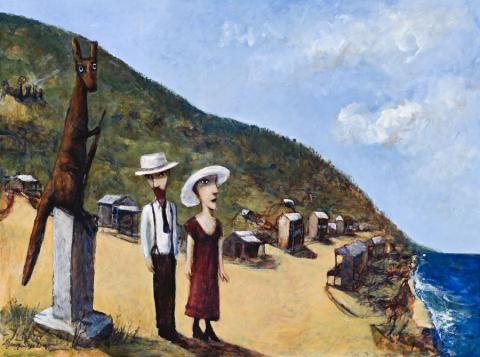THE MONUMENT, 1994
GARRY SHEAD
oil on composition board
91.0 x 121.0 cm
signed and dated lower left: Garry Shead 94
Eva Breuer Art Dealer, Sydney
Private collection, Sydney
Feneley Fine Art, Sydney
Private collection, Sydney
The Monument, 1993, oil on composition board, 91.0 x 121.0 cm, illus. in Grishin, S., Garry Shead: The D.H. Lawrence Paintings, Gordon and Breach Arts International, Sydney, 1993, pp. 110-111
The following excerpts are quoted from Grishin, S., Garry Shead: The D.H. Lawrence Paintings, Gordon and Breach Arts International, Sydney, 1993:
'Twenty-five years ago, while on a trip to the Sepik Highlands in Papua New Guinea, Garry Shead came across an edition of the letters of D.H. Lawrence. This was in 1968, and the letters, particularly the small handful that Lawrence had written from Australia, struck a strange, yet familiar chord in him.
'This first encounter with Lawrence grew into an obsession, so that Garry Shead not only eventually read everything which Lawrence had ever written, but also later studied and re-interpreted many of Lawrence's paintings, and re-traced the author's footsteps to Thirroul, on the south coast near Sydney, where Lawrence had lived with his wife for a couple of months in 1922 and wrote the novel Kangaroo.
'In D.H. Lawrence, Garry Shead found not so much a source of inspiration, as a spiritual affinity. When Lawrence described the Australian bush as weird, empty and untrodden, he seemed to express the same feelings that the painter had experienced. There was also a common perception of mysticism, a sense of spiritual awareness, as well as a similar attitude to the celebration of sexuality. Lawrence came as a great reaffirmation of his own convictions, a validation and crystallisation of ideas with which he had struggled for much of his life. It was as if he had found a spiritual mentor, whose fate was somehow mysteriously and inextricably bound up with his own.'1
'The artistic statement which Garry Shead makes in the Kangaroo paintings is one of provocative simplicity, wit and dramatic power. As with the Lawrence novel, you are left with the feeling that you have encountered something significant and powerful. In both there is a strong narrative where in a way nothing much happens, but a lot of things should happen, and you spend years in your mind seeing them to fruition.'2
1. Grishin, op. cit., p. 7
2. Ibid., p. 18
